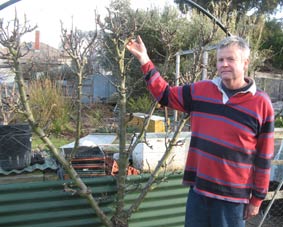edible trees & shrubs
fruit
and nut tree functions
Fruit and nut trees
perform three key functions. As no single fruit tree
performs all three functions it is important to understand
these functions and where it is best to apply them in your
garden.
FUNCTION 1 : food production
The main function of any fruit and nut tree is to produce food for you
to eat. In order to maximise the amount of produce you harvest
from any given tree and to make it as easy as possible to harvest that
produce a tree should be :--
No higher than the height that you can comfortably reach to the topmost branch without having to stand on a ladder.

Espaliered Ballerina apple tree. The top of the tree can be reached comfortably without having to get on a ladder. The down side is that if offers little shade.
- Small enough in size that it can be completely covered with bird netting, again without having to stand on a ladder to put the netting on
There are three ways to keep a fruit tree to a size that is small enough to be managed effectively :-
- Buy a tree that has been grafted onto
dwarf rootstock.
Though even dwarf trees usually need some pruning.
- Regularly prune the tree to keep it's size
small.
- Espalier the tree, which involves a combination of heavy pruning and training of the branches not pruned to a shape that you want, usually elongated.
However the down side of only having espaliered or dwarf fruit trees is that they offer little in the way of shade. In places that have hot dry Summers, such as here in Australia, it is important that at least some of your trees offer you decent shade.
FUNCTION 2 : shade

Morello cherry tree in the chicken run. Due to blackbirds I am rarely able to harvest more than 30 % of the crop but the tree provides plenty of shade for the chickens on hot days.
- Difficult to net. Fruit trees that cannot be
netted often result in most, if not all, of the crop being
lost to birds.
- Need more water than espaliered or dwarf fruit trees.
- Harder to harvest the crop as you have to get up on
ladders to pick much of the fruit.
- If the tree does produce a full crop that isn't eaten by birds you can end up with way too many fruit for the average family to eat or bottle.
- Use ornamental trees that won't require the maintenance
associated with apple trees such as pruning, thinning and
harvesting.
- Plant fruit tree varieties who's fruit either does not, or is less likely attract birds. Examples being citrus trees, feijoas, quince and some apple trees such as crab apples.
FUNCTION 3 : protection for
more sensitive trees

Tangelo tree planted next to a Feijoa tree. The Feijoa tree's bulk acts as a wind break and offers protection against frost. All citrus trees are susceptible to frost and wind damage.
Some examples of hardier trees are Feijoa and olive trees.
The tree lucerne (Tagasaste) also does well in this role. Although it does not produce fruit it is an excellent fodder crop. Rabbits guineapigs and chickens love to eat tree lucerne leaves. Tree lucerne also fixes nitrogen into the ground, which the fruit trees next to it will also benefit from.
As well you can also use a variety of ornamental trees for wind and frost protection.
CONCLUSION
By selecting a combination of tree sizes and types it is possible to
provide shade for people and animals, protection for more sensitive trees,
as well as
supplying
you with plenty of fruit and nuts to eat.
This information is based on observations of trees in a backyard in Ballarat, Australia. The threat posed by birds and weather conditions very greatly throughout the world and what is stated here may not directly apply to your situation.
This information is based on observations of trees in a backyard in Ballarat, Australia. The threat posed by birds and weather conditions very greatly throughout the world and what is stated here may not directly apply to your situation.

